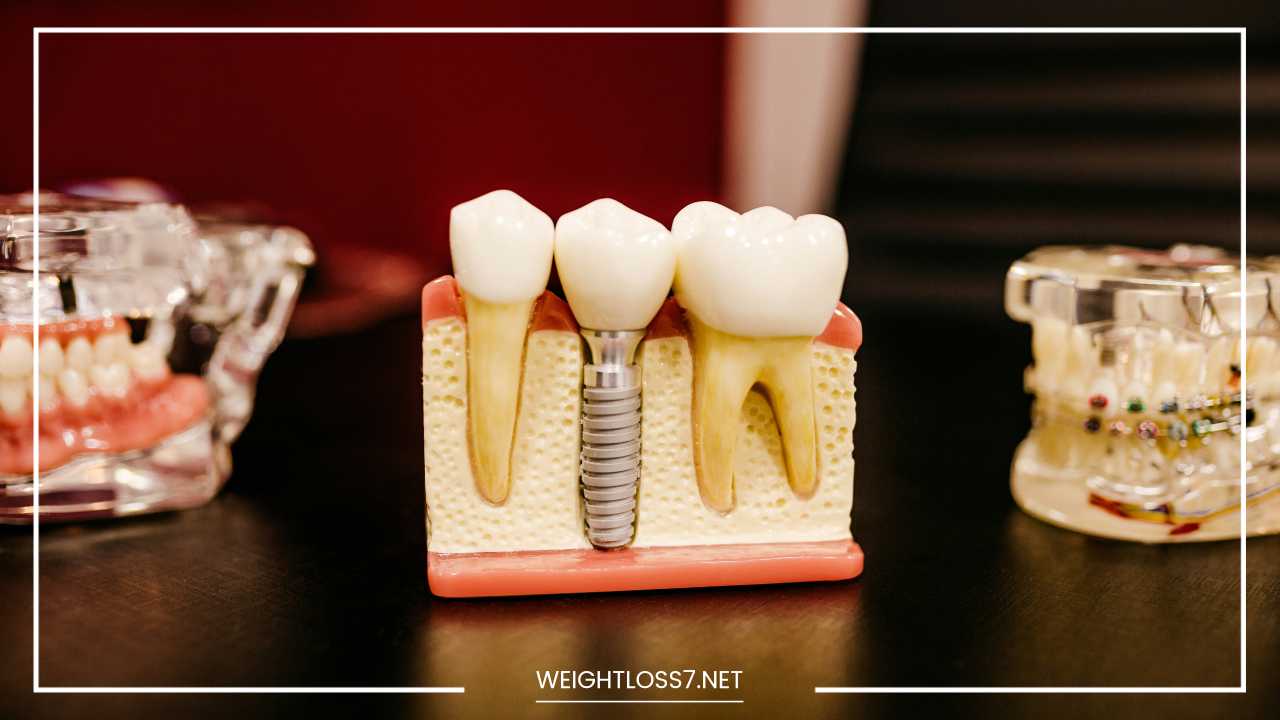Dental Implants 101: Benefits, Procedure & More

Dental Implants
Dental Implants: A Comprehensive Guide to Regaining Your Smile
Dental implants have revolutionized tooth replacement, offering a permanent and life-changing solution for millions of people worldwide.
If you’re missing one or more teeth and contemplating your options, dental implants are a worthwhile investment that can restore your smile, function, and confidence.
This comprehensive guide dives deep into the world of dental implants, equipping you with the knowledge you need to make informed decisions.
We’ll explore the different types of implants available, delve into the intricacies of the procedure itself, navigate the recovery process, and meticulously analyze the benefits and considerations associated with getting dental implants.
Understanding Dental Implants: A Biocompatible Marvel
At the heart of dental implant success lies a biocompatible marvel – the implant itself. Typically crafted from titanium, a remarkably strong and biocompatible metal, these small, screw-like posts act as artificial tooth roots.
Surgically placed within your jawbone, they fuse with the bone over time through a process called osseointegration.
This fusion creates a stable and durable foundation for a dental restoration, such as a crown, bridge, or denture, mimicking the function and aesthetics of a natural tooth.
A Multifaceted Family: Types of Dental Implants
The world of dental implants isn’t a one-size-fits-all solution. There are various types available, each catering to specific situations and jawbone anatomy. Here’s a closer look at the most common implant variations:
-
Endosteal Implants: The Workhorses
- Endosteal implants reign supreme in the implant kingdom. These versatile workhorses are placed directly within the jawbone and come in various sizes and shapes to accommodate different requirements. They are ideal for patients with sufficient jawbone density and offer a long-lasting solution for single or multiple tooth replacements.
-
Subperiosteal Implants: A Solution for Thin Jawbones
- Not everyone is blessed with abundant jawbone density. For patients with a thin jawbone or those who cannot undergo traditional implant surgery due to medical conditions, subperiosteal implants offer a ray of hope. These implants are placed on top of, rather than within, the jawbone and rest on the bone surface. While less common than endosteal implants, they provide a valuable option for specific cases.
-
Zygomatic Implants: Anchoring in the Cheekbone
- Zygomatic implants are the ultimate problem-solvers for complex situations in the upper jaw. When the maxillary sinus cavity, located above the upper jawbone, poses a challenge for traditional implant placement, zygomatic implants come to the rescue. These specialized implants are strategically longer and angled to anchor securely in the zygomatic bone, also known as the cheekbone, providing a stable base for restorations in the upper jaw.
The Dental Implant Procedure: A Step-by-Step Journey
The dental implant procedure is typically an outpatient process spread over several months, ensuring optimal healing and implant success. Here’s a detailed breakdown of what you can expect at each stage:
1. Consultation and Meticulous Planning: Charting the Course
- Your journey begins with a comprehensive consultation with your dentist. They will meticulously assess your oral health, meticulously examine your jawbone density and quality using X-rays and potentially CT scans, and discuss your treatment goals in detail. This initial dialogue lays the foundation for a successful implant treatment plan.
2. Implant Placement Surgery: A Precise Orchestration
- The implant placement surgery is usually performed under local anesthesia or light sedation, ensuring your comfort throughout the procedure. Your dentist will make a meticulous incision in your gum tissue to expose the underlying jawbone. Using specialized tools and meticulous drilling techniques, a precise socket is created in the jawbone to accommodate the implant. The implant is then gently inserted into the socket, and the gum tissue is stitched closed.
3. Healing and Osseointegration: A Foundation Takes Root
- Following surgery, a period of healing and osseointegration commences. During this crucial phase, your jawbone will gradually fuse with the implant surface, creating a strong and stable foundation. This process typically takes several months, and during this time, you’ll likely wear a temporary restoration, such as a denture or crown, to maintain aesthetics and functionality while your implant integrates with the bone.
4. Abutment Placement: The Bridge Between Implant and Restoration
- Once osseointegration is complete, your dentist will revisit the implant site. In a minor procedure, they’ll place an abutment on the implant. This small connector acts as a bridge between the implant itself and the final restoration, such as a crown or bridge. The abutment is usually made of titanium and is custom-designed to seamlessly connect with the implant and the restoration.
5. Final Restoration Placement: Unveiling Your New Smile
- The grand finale arrives with the placement of your permanent restoration. Whether it’s a custom-crafted crown replicating a single tooth, a bridge spanning multiple missing teeth, or a denture securely anchored to implants, the final restoration is meticulously designed to match your natural teeth in color, shape, and function. The dentist will carefully attach the restoration to the abutment, and finally, your dazzling new smile will be unveiled!
Recovery After Dental Implant Surgery: Patience and Care
While dental implant surgery is a well-established procedure, some post-operative discomfort is to be expected. Here’s what you can expect during the recovery phase:
- Swelling and Discomfort: It’s normal to experience some swelling and discomfort around the surgical site for a few days following surgery. Your dentist will prescribe pain medication to manage any discomfort.
- Bleeding: Minor bleeding is also common immediately after surgery. Applying gentle pressure with gauze to the surgical site can help control any bleeding.
- Dietary Adjustments: Opt for soft foods during the initial healing period to minimize pressure on the implant site. Gradually reintroduce firmer foods as your implant heals and discomfort subsides.
- Oral Hygiene: Maintaining meticulous oral hygiene is crucial during recovery to prevent infection. Gently brush and floss around the implant site, following your dentist’s specific instructions.
The healing timeline can vary depending on individual factors like the number of implants placed and your overall health. Typically, complete healing takes several weeks to a few months. Throughout this time, regular follow-up appointments with your dentist are essential to monitor the healing process and address any concerns you may have.
The Advantages of Dental Implants: A Compelling Case
Dental implants offer a plethora of advantages over traditional tooth replacement options like dentures or bridges. Here’s a deeper dive into the compelling reasons to consider dental implants:
-
Enhanced Aesthetics and Confidence: Implants look and function remarkably like natural teeth. They seamlessly blend in with your existing smile, restoring its natural beauty and boosting your confidence. Gone are the days of worrying about dentures slipping or bridges affecting adjacent teeth. With implants, you can smile, laugh, and speak freely without self-consciousness.
-
Improved Functionality and Speech: Traditional dentures can sometimes slip or become loose, impacting your ability to chew and speak clearly. Dental implants, firmly anchored in the jawbone, provide a stable foundation for your restoration, allowing you to eat your favorite foods with confidence and speak clearly without slurring.
-
Durability and Longevity: Crafted from high-quality titanium, dental implants are incredibly durable and can last a lifetime with proper care. Unlike dentures or bridges, which may require replacement every 5-10 years, implants are a long-term investment that pays off over time.
-
Preserving Jawbone Health: Missing teeth can lead to jawbone deterioration. Dental implants, by stimulating the jawbone during chewing, help prevent bone loss and maintain a healthy jaw structure. This not only benefits your oral health but also contributes to facial aesthetics by preventing a sunken appearance.
-
Improved Oral Health: Unlike traditional bridges, which require modification of adjacent teeth, dental implants are standalone restorations. This eliminates the need to alter healthy teeth, thereby promoting overall oral health.
Considerations for Dental Implants: A Balanced Approach
While dental implants offer numerous advantages, it’s important to consider all aspects before making a decision. Here are some key factors to ponder:
-
Cost: Dental implant treatment can be more expensive than traditional tooth replacement options like dentures or bridges. However, their long-term durability and minimal maintenance requirements can make them a cost-effective solution in the long run. Dental insurance coverage for implants can vary, so it’s crucial to check with your provider to understand your specific coverage details.
-
Medical Conditions: Certain medical conditions, such as uncontrolled diabetes or compromised immune systems, may increase the risk of implant failure. Your dentist will thoroughly assess your medical history to determine if implants are the right choice for you.
-
Smoking: Smoking can negatively impact healing and increase the risk of implant failure. If you’re a smoker, quitting smoking is highly recommended before undergoing dental implant surgery.
-
Time Commitment: The dental implant procedure is typically spread over several months, with healing time between each stage. Be prepared to invest time and patience throughout the process.
Building Your Dream Smile: The Consultation is Key
If you’re considering dental implants to restore your smile and improve your oral health, a consultation with a qualified dentist is the first crucial step. During this consultation, your dentist will:
- Conduct a thorough examination of your mouth and teeth.
- Discuss your medical history and any concerns you may have.
- Take X-rays and potentially CT scans to assess your jawbone density and anatomy.
- Explain the different types of dental implants and discuss which option is best suited for your specific needs.
- Provide a detailed treatment plan, outlining the procedure steps, timeline, and associated costs.
- Address any questions you may have and ensure you feel comfortable and informed throughout the process.
Choosing a qualified and experienced dentist specializing in dental implant procedures is vital for achieving optimal results. Don’t hesitate to ask for referrals from friends, family, or your regular dentist. You can also research dentists in your area who have a strong reputation for dental implant surgery.
Beyond the Procedure: Long-Term Care and Maintenance
Once you’ve received your dental implants and enjoyed the revelation of your new smile, proper aftercare is essential to ensure their long-term success. Here are some key practices to maintain healthy implants and a radiant smile:
- Maintain Excellent Oral Hygiene: Brushing twice daily and flossing once daily are crucial for removing plaque and bacteria around the implant site. Your dentist may recommend specific cleaning tools or techniques to effectively clean around the implants.
- Regular Dental Checkups: Schedule regular dental checkups and cleanings with your dentist. These appointments allow your dentist to monitor the health of your implants, gums, and surrounding teeth, and address any potential issues early on.
- Healthy Diet: Maintaining a healthy diet rich in fruits, vegetables, and whole grains is beneficial for overall oral health and implant longevity. Limit sugary and processed foods, as they can contribute to plaque buildup and gum disease.
- Lifestyle Habits: Smoking can negatively impact implant health. If you’re a smoker, quitting is highly recommended. Bruxism, or teeth grinding, can also damage implants. Talk to your dentist about potential solutions if you grind your teeth.
By following these aftercare practices and maintaining good oral hygiene, you can ensure your dental implants thrive for many years to come.
A Brighter Future with Dental Implants: A Rewarding Investment
Dental implants represent a transformative approach to tooth replacement. They offer a multitude of benefits, restoring not just your smile’s aesthetics but also its functionality and confidence.
While the initial investment may be higher than traditional options, the long-term value proposition of dental implants is undeniable.
Their durability, minimal maintenance requirements, and positive impact on oral health make them a worthwhile investment in your overall well-being.
If you’re considering dental implants, consult with a qualified dentist to discuss your specific needs and explore if they are the right solution for you.
With careful planning, skilled execution, and proper aftercare, dental implants can pave the way for a brighter future with a healthy, confident smile.

















